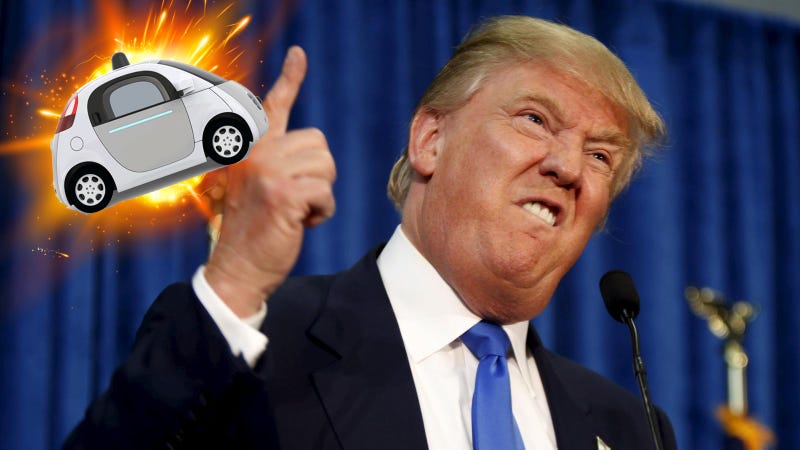
When you really get down to it, life is a constant struggle to maintain the illusion of control. Take those stupid buttons at crosswalks. The ones you jab while waiting for the hand to turn into the walking dude. That button does nothing—the traffic lights are on timers. Pressing the button over and over is pure placebo. But you press it, we all press it, because we need to pretend we’re not powerless.
The entire premise of self-driving cars is that humans do not need this illusion of control. One day, there may be cars with no pedals, no steering wheel, no emergency brake. Most people find this terrifying. It’s a nightmare for car enthusiasts. There’s a reason one of the most famous films in history is about a robot, very politely, telling a human to fuck off.
President Donald Trump, it turns out, is one of those people who is also deeply skeptical and even disdainful of autonomous vehicles, according to an Axios report:
In the summer of 2017, at his Bedminster golf club, Trump was chatting with club members when one raised the subject of AV technology. The club member was “excited” about a new Tesla he bought, recalled a source who was part of the conversation. “And [Trump] was like, ‘Yeah that’s cool but I would never get in a self-driving car. … I don’t trust some computer to drive me around.’”
The phrase “out-of-control death traps” was also thrown around, which is delightful.
Advertisement
While we have had our, uh, disagreements with the president on a great number of matters, such as tax policy, trade policy, and the nature of evidence and truth itself, this is not only a perfectly reasonable fear to have, but also a very common one.
In early 2017, the American Automobile Association found 78 percent of U.S drivers are afraid to ride in a fully-autonomous cars. That number went down to 63 percent by the end of the year, but their most recent study found an increase back to up 71 percent after “a number of high-profile automated vehicle incidents,” by which AAA means a self-driving car detected a person was in front of it but decided not to stop.
And that skepticism has been especially justified following a number of high-profile incidents involving autonomous or semi-autonomous cars, like fatal Tesla Autopilot crashes or the death of a pedestrian crossing a road at the hands of an Uber test vehicle.
Advertisement
Traditionally, widespread public concern about private companies introducing products to market that are scary and dangerous results in regulation. But the really important part is this: when Axios notes, “Currently, there are no federal regulations on self-driving cars — just a hodgepodge of state rules.” As this technology grows in both testing and practical use, that will need to change at some point, and it’s unlikely it will be during this administration.
Meanwhile, the U.S. Department of Transportation is seeking public comment on allowing cars without steering wheels or pedals. This is the same DOT, mind you, that, according to the Seattle Times, largely ceded regulatory oversight to Boeing over its 737 MAX computerized flight correction technology, the widely suspected cause of two crashes and hundreds of deaths.
Advertisement
How much of this fear about the self-driving future is actually a fear the federal government won’t adequate regulate it? Is this really a story about eroding trust in government rather than in self-driving technology itself? The answer likely differs depending on who you are. I suspect that is not the root of Trump’s concern; he is the president, after all, and the stakes are low for him. He’s perfectly happy letting other humans drive and fly him around.
But, at least for my part, I can appreciate the potential safety and efficiency improvements self-driving cars could offer down the line, but fearful the industry is racing rather than waiting for the right blend of mature technology, social adjustment, and a willing populace. (And remember, at the end of the day, they exist to make money ahead of everything else.)
Advertisement
These concerns are only heightened when I see posts like this titled “Trusting Driverless Cars” from the Google Design lab:
When you hop into one of our cars, one of the first things you’ll notice is our passenger screen. It’s there to reassure you that you’re in the right car, and that the car knows where you’re going. The second thing you might notice is the sound. We play a relaxing, ambient track as you’re settling in. Waymo’s soundscape is composed in the musical key of E, which, according to our sound designer, represents the expression of “joy, magnificence, and the highest brilliancy.”
Oh, God yes. Play me the most docile tones composed in the key of E as I bask in the magnificence and joy of losing all control.















